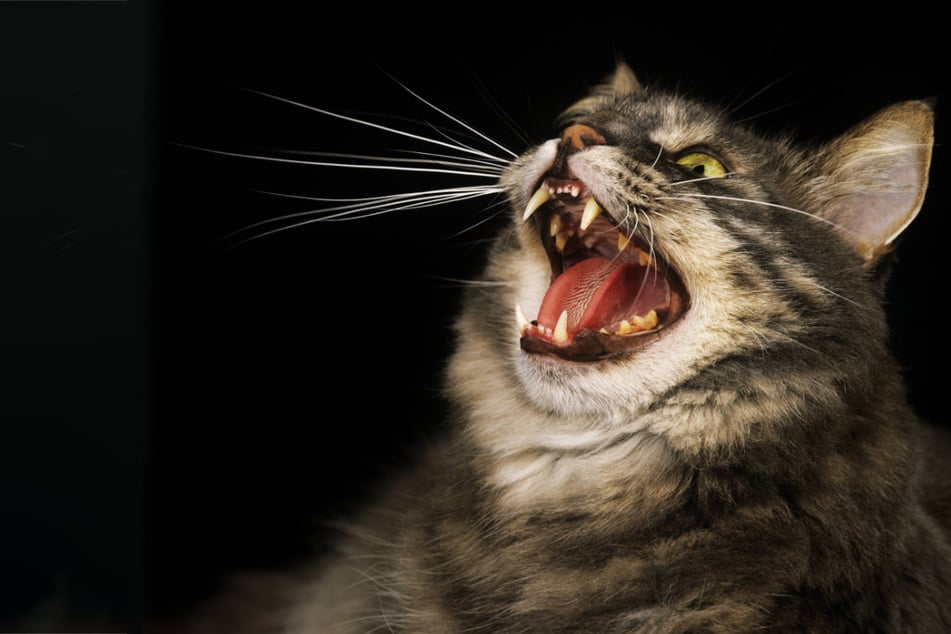How do I say sorry to my cat? Why cat apologies are important
If you think that your cat is mad at you for something, you're probably right. They can be grumpy little mammals! We take a look at how to say sorry to a cat, and why cat apologies are so important.

We have all been in the presence of an angry kitty.
With those big eyes, that giant scowl, that look of utter disgust that sinks our heart faster than the Titanic, the desire to apologize for our misdoings becomes stronger than ever before. After all, who could resist that angry little face?
In this cat guide, TAG24 takes you through everything that you need to know about what makes a cat apology good. Here's how to say sorry to your cat, and everything you need to know about cat forgiveness...
Do cats forgive?
Once a cat has entered a bad mood, it's going to take a while for them to feel better. They are grumpy fellows that find it hard to digest tricky and annoying things. If you accidentally step on your four-pawed friend's tail, for example, it's going to get pretty irritated, take flight, and be rather upset with you.
It might have been a mistake from your perspective, but your cat does not possess the cognitive skills for that level of logic. From its perspective, you hurt it and thus, you should suffer for it. Vindictive, right? Well, yeah, it's a cat! But what can you do about it? Can you apologize to a pissed off cat?
Yes, you can apologize to a cat, but that doesn't mean it will instantaneously forgive you. Instead, a cat will forgive you once you have fully regained its trust. A cat apology is more than a "sorry". Much more...
How long does it take your cat to forgive?
It somewhat depends on how bad the injury or scare was that caused your cat to be upset. Ultimately, a cat will forget your misdeeds within a few hours. If it is more extreme, it might take more time. In such a case, it is best for you to take a few more "apology" steps and say sorry to your cat by regaining its trust.
When should you apologize to a cat?
Unlike with a human, it is often best to wait a little while before saying sorry to your cat. Give it at least an hour, as you want your cat's adrenaline rush and fear to have subsided after the injury or scare, so that it doesn't feel chased or overwhelmed.
You need to be careful when your cat is feeling this way, as it will freak out even easier than usually. Let it be, and don't approach your four-legged friend until it is calm and ready for a good cuddle and pat. Do this for your own self-preservation, as well, for when your cat is like this, it is more likely to lash out at you, too!
Why is my cat mad at me and how do I know?

There are a variety of signs that point towards your cat being a little annoyed at your behavior, or perhaps even angry. When your cat is upset or angry, you should steer clear and give it some time before trying to make amends!
Here are some signs of an angry cat:
- In the tail:
- If the tail is soft and slightly bent in your direction, things are OK
- When the tail is twitching or swishing, consider it a warning
- In the case that its tail is pointed, rigidly, upwards, it is afraid
- If your cat has a twitchy tail, or keeps slapping the floor, it's angry
- In the ears:
- If your cat's ears stand upright, it is probably OK
- When your cat's ears are directed backwards, then it may be frightened
- In the case that a cat's ears are close to its head, or flat down, it could be quite angry
- In the eyes:
- If your cat's pupils are huge and have noticeably and quickly grown, it could be that the animal is scared or anxious
- when your cat's pupils become very small, though, it is a sign of anger, annoyance, or perhaps even excitement
Just so you know: Your cat's pupil size is not always as indicative as you might think. Just like in humans, a cat's pupils will dilate when it is darker as they try to collect more light for a better picture. When it is bright, they will shrink as a protective mechanism.
- In the fur:
- If your cat's fur looks exactly the same as always, then don't worry
- In the case that your cat's fur is standing straight on end and is all puffed up, your cat is almost certainly furious
- In the claws:
- Be weary of a cat which has its claws stick out consistently, it could be angry and awaiting an opportunity to attack
Look out for these various signs to figure out whether your cat is upset with you, and whether a cat apology is in order!
How to apologize to a cat
The most important thing when dealing with an angry, annoyed, or upset cat is to interpret the signals we just listed and stop whatever behavior is causing this anger. It is also important, though, to differentiate between a cat that is angry, and a cat that has lost trust in you.
If your cat is just simply annoyed or angry, leave it alone for a while and it will calm down. In the case that you have frightened, hurt, or upset your cat in another way, though, it is best to leave them alone for a while, return, and perform some trust-building exercises.
Let's take a look at a few ways you can regain your cat's trust and perform a truly successful cat apology...

A step-by-step guide to cat apologies
Once you have given your cat a little bit of time to calm down, it's time to apologize. The act of saying sorry isn't a verbal one, but rather a physical one when it comes to cats. It's less about saying, "Hey bro, I'm sorry," and more about treating your kitty with love, patting with affection, so on and so forth.
Here's how to say sorry to your cat:
Step 1: Grab a treat and have it ready for your cat. If it allows you to get close, try to give it the treat. In the case that your cat is a bit weary of you, place it on the floor in clear view and walk a couple of paces away from it.
Step 2: Make sure to talk to your kitty, keeping your voice calm and sweet so that it is soothing a gentle. Feel free to use apologizing words, but remember that your kitty can't speak your language.
Step 3: Look at your four-legged friend in full-view and directly into its eyes. Purposefully blink slowly, as this is perceived by your kitty as a sign of trust. Hold out your hand for a pat.
Step 4: Try to stroke your cat in its favorite spots, and make sure that it feels as comfortable as can be. Make sure to pat your cat properly, and avoid any common mistakes that may make them feel uncomfortable or unhappy.
Step 5: Try to pay as much attention to your cat as possible, but without overwhelming it. Respond to its needs, give it food, and make sure that you prove your love in as many ways as possible!
Remember that, ultimately, a cat apology is basically just a way of regaining its trust. Show it affection, give it food, and make sure that you don't repeat the offending behavior.
I hit my cat, now it hates me, what should I do?
It is worth noting that you absolutely, under no circumstances, should ever hit your cat. This is abusive and cruel, and could seriously hurt your beloved feline friend.
That being said, sometimes you will make a mistake and perhaps step on its tail in the darkest of nights, or absent-mindedly walk into it. Sometimes you annoy the living heck out of your cat, and that's when a cat apology is warranted.
If you interpret the signals being sent to you correctly, and know the preferences of your kitty, then you're in for success. Just say sorry to your cat in a careful and considerate way, and your apology will regain its trust and love!
Cover photo: IMAGO / Anka Agency International



